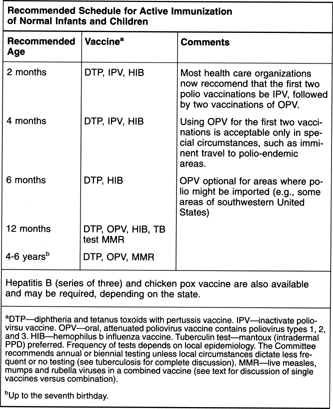Alphabetic Guide to Child Care - Immunization
Immunization
Recently developed vaccines against measles, mumps, and rubella (German measles) should eventually wipe out these diseases in the same way that smallpox has been eliminated practically everywhere in the world. Routine immunization follows a schedule of shots administered with minor variations by most pediatricians and child care clinics. Severe reactions are rare, but should they occur, they should be reported to the physician promptly.
Keeping Records
Records should be kept of the child's immunization history so that booster shots can be given at proper intervals. Because families move from one place to another, changing physicians as they relocate, it saves a great deal of time and trouble if immunization data is written down rather than committed to memory.
See HEALTH RECORDS .

| Recommended Age | Vaccine | Comments |
|---|---|---|
| Hepatitis B (series of three) and chicken pox vaccine are also available and may be required, depending on the state. | ||
| a DTP—diphtheria and tetanus toxoids with pertussis vaccine. IPV—inactivate polio-virsu vaccine. OPV—oral, attenuated poliovirus vaccine contains poliovirus types 1,2, and 3. HIB—hemophilus b influenza vaccine. Tuberculin test—mantoux (intradermal PPD) preferred. Frequency of tests depends on local epidemiology. The Committee recommends annual or biennial testing unless local circumstances dictate less frequent or no testing (see tuberculosis for complete discussion). MMR—live measles, mumps and rubella viruses in a combined vaccine (see text for discussion of single vaccines versus combination). | ||
| b Up to the seventh birthday. | ||
| 2 months | DTP, IPV, HIB | Most health care organizations now reccomend that the first two polio vaccinations be IPV, followed by two vaccinations of OPV. |
| 4 months | DTP, IPV, HIB | Using OPV for the first two vaccinations is acceptable only in special circumstances, such as imminent travel to polio-endemic areas. |
| 6 months | DTP, HIB | OPV optional for areas where polio might be imported (e.g., some areas of southwestern United States) |
| 12 months | DTP, OPV, HIB, TB test MMR | |
| 4-6 years | DTP, OPV, MMR | |
DTP Injections
DTP stands for diphtheria, tetanus, and pertussis (or whooping cough). DTP injections are usually given in the muscles of the mid-thigh or upper arm, at intervals of one month, sometimes longer. To prevent fever or other severe reactions, the two- to five-month-old baby should receive acetaminophen within a few hours after the injection. If she nevertheless develops fever or has other severe reactions, your physician may have to give lower doses, and therefore give more than three injections. Very rarely is a severe reaction reported with smaller doses of the vaccine. If there is such a reaction, no further injections of pertussis vaccine will be given.
Occasionally, redness or a lump appears at the site of the injection. This is a local reaction. It is harmless and will disappear within a few weeks. If it does not, consult your physician.
DTP Reactions
Adverse reactions to the DTP vaccine have been reported in a few cases. The reactions ranged from permanent neurological damage to such mild symptoms as persistent crying and unusual sleepiness. Crying may be high-pitched and may continue as long as three hours or more. Sleepiness may resemble a shocklike state. Some children may run temperatures of 105° F or higher. In cases of suspected adverse reactions to DTP or any other vaccine, a pediatrician or family physician should be called immediately.
Parents may want to discuss their children's medical histories with their family physicians or pediatricians before taking a child in for an inocculaton. The American Academy of Pediatrics suggests that children with personal histories of convulsions or allergic reactions to DTP or other vaccines should not be given the DTP vaccine. The same is true of children born prematurely.

Comment about this article, ask questions, or add new information about this topic: